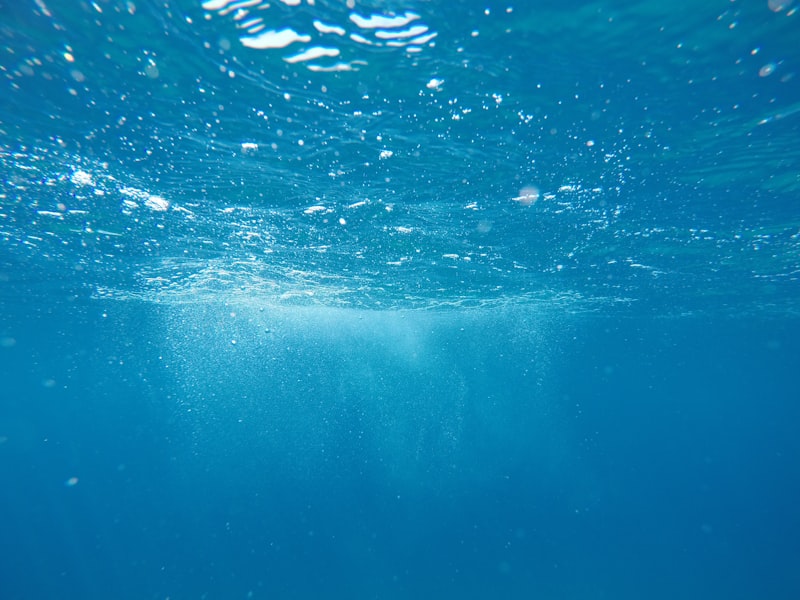Have you ever wondered what lurks in the depths of our oceans, far from the reach of sunlight? The world beneath the waves holds a treasure trove of mysteries, especially when it comes to deep sea fish species. These creatures, adapted to survive under extreme pressure and darkness, boast bizarre appearances that defy imagination.
One of the most fascinating deep sea fish is the anglerfish. Found in the darkest depths where sunlight cannot penetrate, this fish uses a bioluminescent lure dangling from its head to attract prey. It’s like a natural fishing rod! The female anglerfish is notably larger than the male and is known for the unusual method of reproduction where the male fuses onto her body, becoming a permanent mate.
Another peculiar inhabitant of the deep sea is the gulper eel. Known for its expandable mouth, the gulper eel can swallow prey much larger than itself, resembling a creature straight out of a science fiction movie. Its long, slender body and large mouth make it an effective predator in the pitch-black waters where it resides.
The vampire squid, despite its ominous name, is more of a gentle drift-through-the-water type of creature. Residing in the oxygen-minimum zones of the ocean, it uses bioluminescent photophores to create dazzling light shows, possibly to deter predators or attract prey.
Imagine encountering the barreleye fish, which has transparent head-capsules revealing its tubular eyes that can rotate within its head. These eyes are adapted to detect the faintest traces of light filtering down from above, helping it spot potential meals in the darkness.
Deep sea fish species are a testament to the incredible diversity and adaptability of life on Earth. Their strange forms and behaviors continue to intrigue scientists and adventurers alike, offering a glimpse into a world that remains largely unexplored and full of surprises.
Discover the Bizarre World of Deep Sea Fish Species
Have you ever wondered what lurks beneath the dark depths of the ocean? The world of deep sea fish species is as bizarre as it is fascinating, filled with creatures that seem like they’re from another planet. These deep sea denizens have evolved in extreme conditions, far away from the sun’s reach, creating adaptations that are both astonishing and sometimes eerie.
Imagine encountering the anglerfish, a creature with a bioluminescent lure dangling from its head like a fishing pole. It uses this light to attract prey in the darkness, making it a truly masterful predator of the deep. Or consider the gulper eel, which has a stretchy stomach that can expand to swallow prey much larger than itself, resembling a bizarre vacuum cleaner of the ocean floor.
Then there’s the viperfish, known for its needle-like teeth and oversized jaw that can capture prey with swift precision. Its elongated body and photophores along its sides emit a haunting glow, aiding in camouflage and possibly attracting mates in the vast darkness. These adaptations not only showcase survival strategies but also highlight the surreal beauty of deep sea creatures.
Exploring the depths further, you might encounter the fangtooth, aptly named for its menacing teeth that protrude from its mouth even when closed. Despite its ferocious appearance, it mainly feeds on small fish and crustaceans, illustrating the diversity of diets among deep sea predators. Each species has its niche in this mysterious ecosystem, adapted to the pressures and challenges of life in the abyss.
Diving into the world of deep sea fish species is like discovering a realm of alien life forms right here on Earth. Their adaptations, behaviors, and appearances evoke both awe and curiosity, reminding us of the vast and often unexplored wonders hidden beneath the ocean’s surface.
This article captures the intrigue and wonder of deep sea fish species while maintaining a conversational tone and incorporating engaging details to captivate the reader’s interest.
10 Most Astonishing Deep Sea Fish Species You’ve Never Seen
-
Dragonfish: Known for their bioluminescent capabilities, dragonfish possess long, fang-like teeth and a barbel that emits light to lure prey.
-
Fangtooth Fish: Despite their menacing appearance with long, needle-like teeth, fangtooth fish are only a few inches long and live in the deep ocean trenches.
-
Barreleye Fish: These fish have transparent heads, allowing their tubular eyes to rotate within their transparent shield, giving them a unique appearance to see above and prey.
-
Gulper Eel: The gulper eel, also known as the pelican eel, has a large mouth that it can open wide to swallow prey much larger than itself in a sudden attack to eat.
-
Viperfish: Viperfish, named for their needle-like teeth, use bioluminescent organs along their belly to attract prey in the dark.
-
Chimaera: Often referred to as “ghost sharks,” chimaeras have elongated bodies and large, wing-like fins, giving them an otherworldly appearance.
-
Blobfish: Blobfish live in the deep sea and have a gelatinous appearance when brought to the surface due to the lack of the high-pressure deep sea.
-
Anglerfish: Female anglerfish have a bioluminescent lure called an illicium that they dangle in front of their mouths to attract prey in the deep.
-
Hatchetfish: Hatchetfish have thin, flattened bodies and luminescent organs along their undersides that can make them nearly invisible in the dark.
Journey into the Abyss: Strange Deep Sea Fish Species Revealed
One of the most intriguing inhabitants of this realm is the anglerfish, famed for its bioluminescent lure dangling above its mouth like a fishing rod. This adaptation attracts unsuspecting prey towards its razor-sharp teeth, highlighting the ingenuity of nature in the darkest corners of the ocean.
Equally bizarre is the viperfish, known for its long, needle-like teeth and large eyes adapted to see in minimal light. This predator uses its luminescent photophores to illuminate prey, striking with astonishing speed and agility.
The gulper eel, with its expandable stomach and snake-like appearance, is another marvel of deep-sea adaptation. Its oversized jaws allow it to swallow prey much larger than itself, surviving in an environment where food can be scarce and sporadic.
The lanternfish, though small, plays a crucial role in the deep-sea ecosystem by migrating vertically each day, carrying nutrients from the depths to shallower waters. Their bioluminescence not only helps them navigate but also serves as a defense mechanism against predators lurking below.

Exploring these deep-sea marvels unveils a world of evolutionary wonders, where survival hinges on extraordinary adaptations. Each species, from the bizarre anglerfish to the elusive vampire squid, contributes to the intricate tapestry of life in the abyss, reminding us of the vastness and resilience of nature in Earth’s last frontier.
From the Depths: Weird and Wonderful Deep Sea Fish Species
Have you ever wondered what lurks beneath the surface of the ocean, in the mysterious world of the deep sea? Prepare to be amazed as we dive into the realm of some of the most bizarre and fascinating creatures on Earth – deep sea fish species.
Imagine a world where sunlight never reaches, and the pressure is immense. Deep sea fish have evolved unique adaptations to survive in this extreme environment. One such marvel is the Anglerfish, famous for its bioluminescent lure dangling from its head like a fishing rod. This lure attracts unsuspecting prey in the darkness, making it a deadly predator despite its eerie appearance.

Then there’s the Goblin Shark, often referred to as a living fossil due to its ancient lineage. With a long, flat snout and a jaw that extends outward to catch prey, this deep sea dweller is a testament to the mysteries of evolution.
For those fascinated by the weird and wonderful, the Viperfish is another creature to behold. Known for its needle-like teeth so long they don’t fit inside its mouth, this fish uses its luminescent photophores to attract prey in the abyssal blackness.
Moving on, the Hatchetfish earns its name from its unique shape resembling a hatchet. With silver sides and an almost transparent body, it reflects light to blend seamlessly into its surroundings, evading predators while hunting smaller fish and plankton.
Last but not least, the Barreleye Fish, also known as the Spookfish, has transparent fluid-filled dome-like eyes that rotate within its head. This adaptation allows it to look directly upward, spotting prey or potential threats from above in its dark habitat.
These deep sea fish species are just a glimpse into the diverse and alien world beneath the waves. Each one adapts uniquely to survive in an environment that challenges life in every way. Next time you gaze out at the ocean, remember that below the surface lies a realm filled with creatures both strange and wondrous, waiting to be discovered and understood.
Frequently Asked Questions
How do deep-sea fish survive in extreme pressure environments?
Learn how deep-sea fish survive in extreme pressure environments with our concise FAQ. Discover their specialized adaptations and biological features that enable them to thrive in the depths of the ocean.
What are some unique adaptations of deep-sea fish species?
Discover fascinating adaptations of deep-sea fish species, including bioluminescence, extreme pressure tolerance, and unique sensory adaptations. Explore how these features enable survival in the ultimate depths of the ocean.
Where can one find deep-sea fish species and how are they studied?
Discover where deep-sea fish species are found and learn about their study methods. Explore the depths of the ocean where these unique creatures thrive, and understand the scientific approaches used to observe and analyze their behaviors and habitats.
What are examples of bioluminescent deep-sea fish species?
Explore fascinating examples of bioluminescent deep-sea fish species, such as the anglerfish, lanternfish, and hatchetfish. These remarkable creatures emit light through specialized organs, aiding in communication, camouflage, and attracting prey in the depths of the ocean.
Why are deep-sea fish often bizarre in appearance?
Discover why deep-sea fish often exhibit bizarre appearances. Explore how their unique adaptations to extreme environments, like bioluminescence and elongated bodies, contribute to their peculiar looks.


